[XENEA Wallet] Daily Quiz March Answers and Trivia! ✨️ updated daily ✨️

👉February Answers and Trivia
👉January Answers and Trivia
XENEA Wallet features a Daily Quiz that enhances user engagement while offering a fun and gamified way to learn about Web3 and the Xenea ecosystem.
Although many kind individuals are sharing answers on X (formerly Twitter), it feels like the quiz is turning into a game of simply picking the right answer without understanding the questions. To address this, this article will provide not only the answers to XENEA Wallet’s Daily Quiz but also the reasoning behind them and additional insights. By leveraging XENEA Wallet NAVI (ChatGPT), we aim to make the experience more informative and meaningful.
It takes less than a minute, so bookmark this page and check back daily! 😊
Start Your Journey with XENEA Wallet Today!
XENEA Wallet is an innovative app that makes exploring the world of Web3 both fun and rewarding! Complete simple missions, claim daily bonuses, and earn rewards while learning about the future of digital technology.
With cutting-edge security and unparalleled convenience, XENEA Wallet offers you the chance to participate in future airdrops and mining opportunities. Simply download the app to begin your new digital experience!
New users can start with 1,000 gems by signing up with the invite code below!
1️⃣ Download the app
2️⃣ Enter the invite code: h3dYzHejPI
3️⃣ Sign up with your Google or Apple account
Enjoy the exciting world of XENEA Wallet!
Please refer to the following page for information on how to earn Gems.
How many days does it take to earn 10,000 gems and start automatic mining with the XENEA Wallet?
Daily Quiz on Mar 31
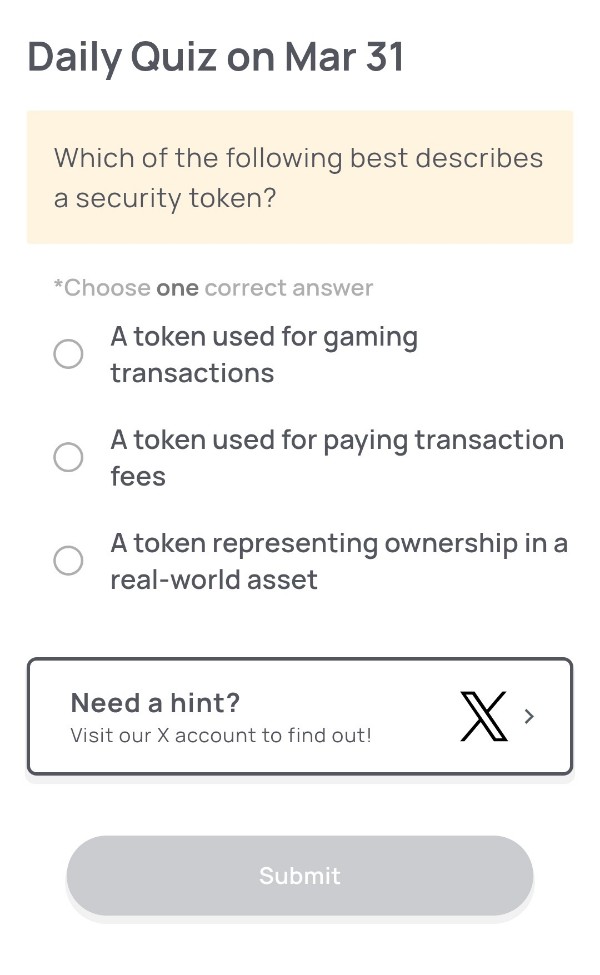
🟢Quiz Questions:
Which of the following best describes a security token?
🟢Choose one correct answer:
・A token used for gaming transactions
・A token used for paying transaction fees
・A token representing ownership in a real-world asset
🟢Answer:
A token representing ownership in a real-world asset
🟢Reason for choosing this answer:
A security token is a type of digital asset that represents ownership or a stake in a real-world asset such as real estate, stocks, or bonds. These tokens are subject to securities regulations and offer rights such as dividends or profit-sharing, making them distinct from utility tokens or transactional tokens.
🟢Trivia:
Security tokens are typically issued on blockchains through Security Token Offerings (STOs) and must comply with regulatory frameworks like the U.S. SEC. They aim to bring liquidity, transparency, and global access to traditional investment assets by tokenizing them on decentralized ledgers.
Daily Quiz on Mar 30
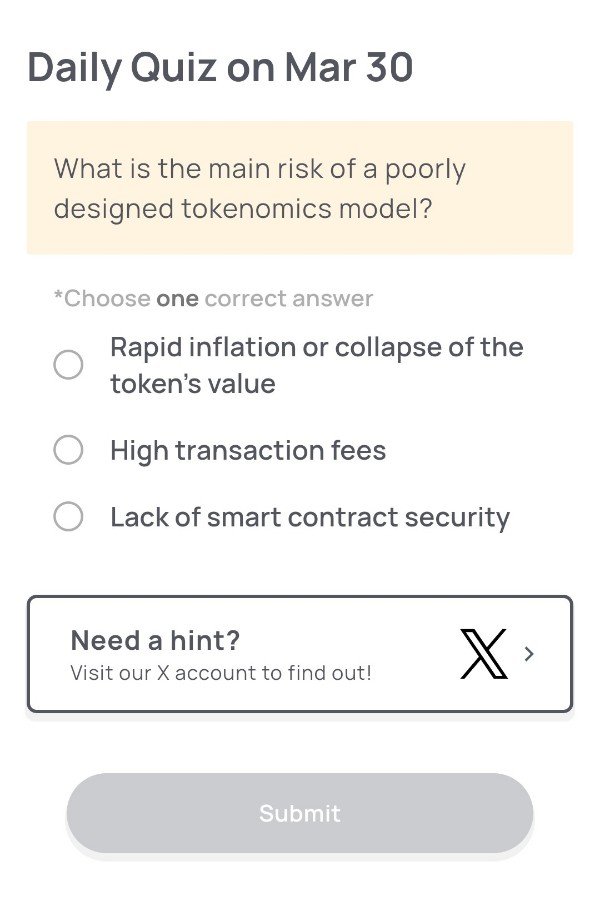
🟢Quiz Questions:
What is the main risk of a poorly designed tokenomics model?
🟢Choose one correct answer:
・Rapid inflation or collapse of the token’s value
・High transaction fees
・Lack of smart contract security
🟢Answer:
Rapid inflation or collapse of the token’s value
🟢Reason for choosing this answer:
Poorly designed tokenomics can result in an imbalance between supply and demand. For example, if too many tokens are issued too quickly without corresponding demand, it can lead to inflation and devaluation of the token. Conversely, if tokens are locked up or distributed unfairly, it can limit liquidity and cause market instability. Tokenomics is central to maintaining value and trust in the ecosystem.
🟢Trivia:
Xenea’s token, XENE, uses a capped supply model with halving every two years for mining rewards—similar to Bitcoin. This is intended to prevent over-inflation and maintain long-term value. Its well-thought-out tokenomics align incentives for network participants such as DACS nodes and PoD consensus participants.
Daily Quiz on Mar 29
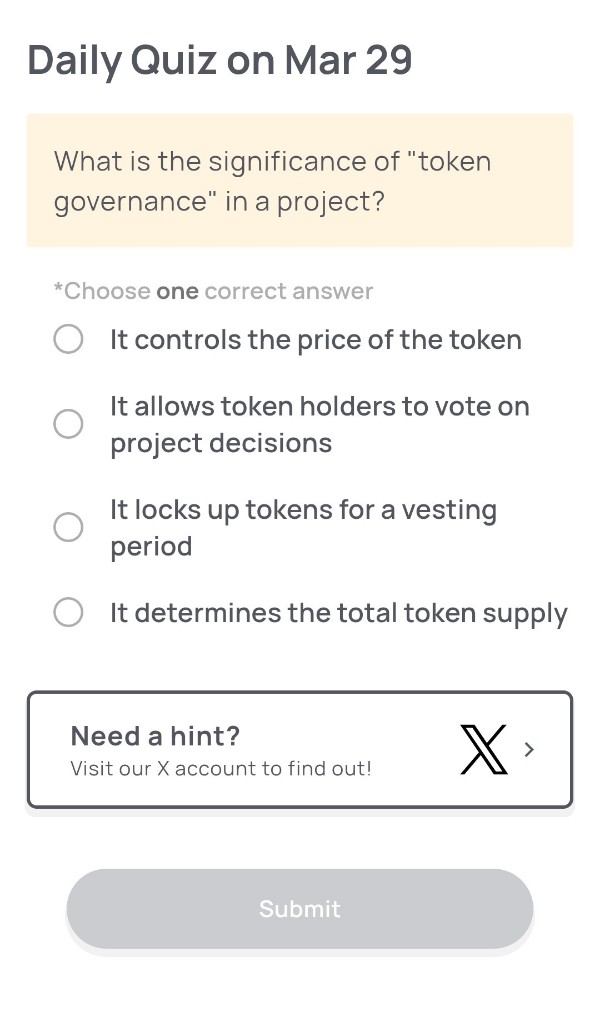
🟢Quiz Questions:
What is the significance of “token governance” in a project?
🟢Choose one correct answer:
・It controls the price of the token
・It allows token holders to vote on project decisions
・It locks up tokens for a vesting period
・It determines the total token supply
🟢Answer:
It allows token holders to vote on project decisions
🟢Reason for choosing this answer:
“Token governance” refers to a decentralized mechanism where holders of a project’s native token can vote on key decisions related to the project’s future—such as protocol upgrades, funding allocations, or parameter changes. It empowers the community and promotes decentralization by giving actual stakeholders (token holders) a voice in the development and direction of the project.
🟢Trivia:
Xenea’s native token, XENE, also plays a governance role. Holders and their agents can participate in governance over proposals, including protocol upgrades and parameter adjustments, through a system expected to evolve with the launch of Xenea Improvement Proposals (CIP).
Daily Quiz on Mar 28
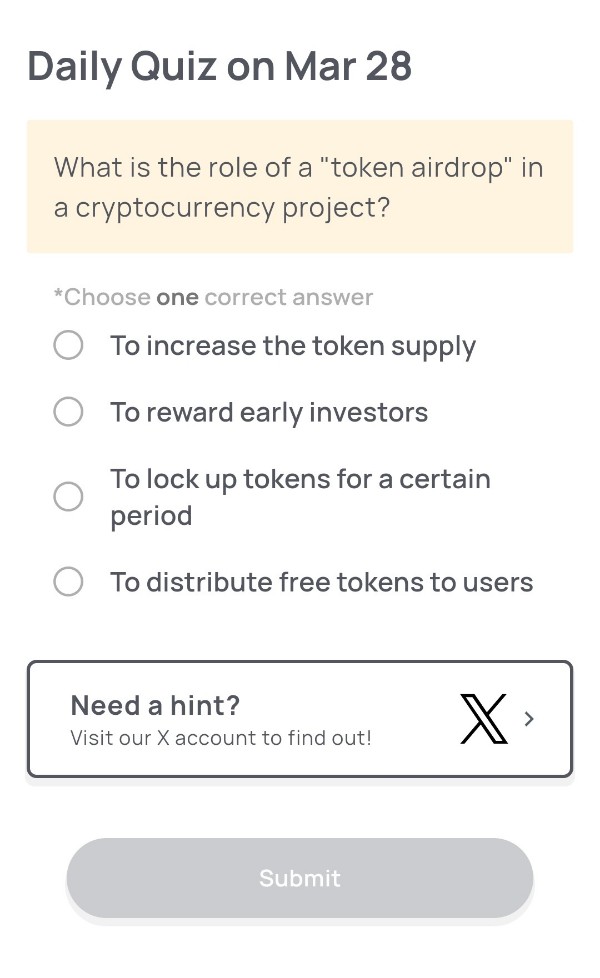
🟢Quiz Questions:
What is the role of a “token airdrop” in a cryptocurrency project?
🟢Choose one correct answer:
・To increase the token supply
・To reward early investors
・To lock up tokens for a certain period
・To distribute free tokens to users
🟢Answer:
To distribute free tokens to users
🟢Reason for choosing this answer:
A “token airdrop” is a common marketing strategy in cryptocurrency projects where tokens are distributed for free to users. This is often done to raise awareness, encourage user participation, and stimulate demand or network activity. Airdrops may target existing users of a blockchain, new users, or participants of specific activities.
🟢Trivia:
Some famous airdrops like Uniswap (UNI) and Arbitrum (ARB) rewarded early users with substantial token allocations—sometimes worth thousands of dollars. These events help decentralize token ownership and foster community engagement. However, recipients often must meet certain conditions, such as interacting with the protocol or holding specific assets.
Daily Quiz on Mar 27
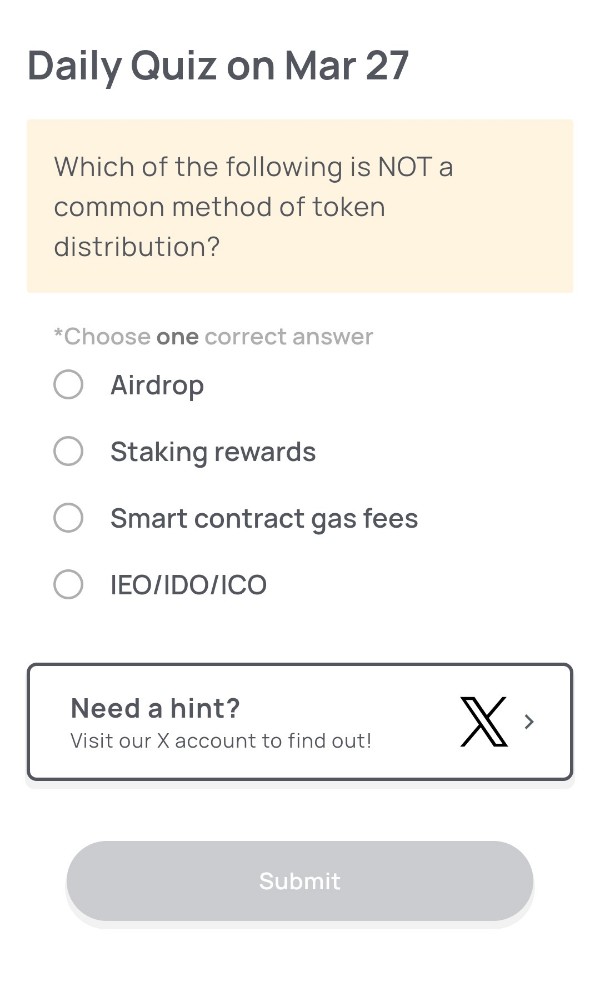
🟢Quiz Questions:
Which of the following is NOT a common method of token distribution?
🟢Choose one correct answer:
・Airdrop
・Staking rewards
・Smart contract gas fees
・IEO/IDO/ICO
🟢Answer:
Smart contract gas fees
🟢Reason for choosing this answer:
Gas fees are costs users pay to execute transactions or run smart contracts on a blockchain. They are not a distribution method for tokens but rather a payment mechanism. In contrast, Airdrops, Staking rewards, and IEO/IDO/ICO are all established ways to distribute tokens to users or investors.
🟢Trivia:
Airdrops are often used by new projects to promote awareness and reward early users. Staking rewards encourage users to lock up tokens and help secure the network, common in Proof-of-Stake systems. IEO (Initial Exchange Offering), IDO (Initial DEX Offering), and ICO (Initial Coin Offering) are fundraising methods where investors receive tokens in exchange for their contribution.
Daily Quiz on Mar 26
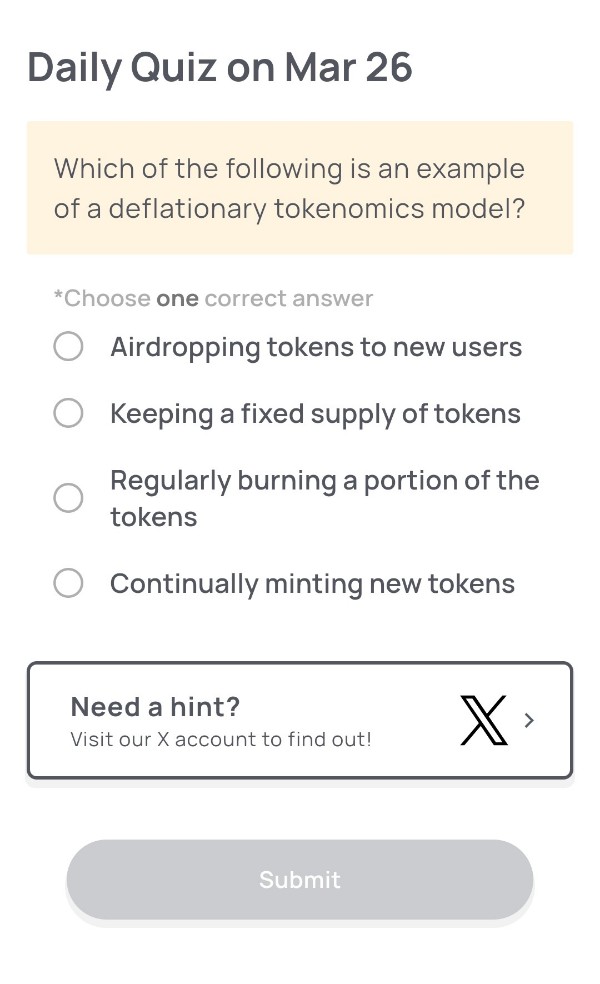
🟢Quiz Question:
Which of the following is an example of a deflationary tokenomics model?
🟢Choose one correct answer:
・Airdropping tokens to new users
・Keeping a fixed supply of tokens
・Regularly burning a portion of the tokens
・Continually minting new tokens
🟢Answer:
Regularly burning a portion of the tokens
🟢Reason for choosing this answer:
A deflationary tokenomics model reduces the overall supply of tokens over time, which can potentially increase scarcity and value. “Regularly burning a portion of the tokens” literally means destroying or removing them from circulation, directly reducing the total supply. This is a typical deflationary mechanism used in many crypto projects.
🟢Trivia:
Xenea also includes a potential deflationary aspect in its tokenomics. While XENE has a capped total supply and follows a halving schedule for mining rewards, the documentation mentions that some of the gas fees collected by the network may be burned through future changes, suggesting a deflationary model might be implemented in part.
Daily Quiz on Mar 25
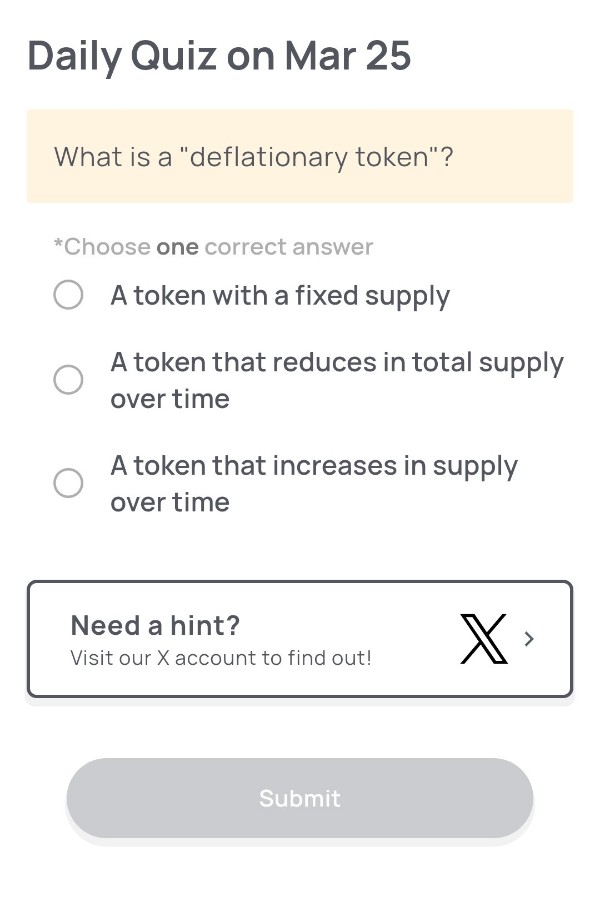
🟢Quiz Question:
What is a “deflationary token”?
🟢Choose one correct answer:
・A token with a fixed supply
・A token that reduces in total supply over time
・A token that increases in supply over time
🟢Answer:
A token that reduces in total supply over time
🟢Reason for choosing this answer:
A deflationary token is designed to decrease in supply over time, often through mechanisms like token burning. This reduction in supply can potentially increase the value of the token, assuming demand remains steady or increases. Unlike fixed-supply tokens, deflationary tokens continuously shrink the circulating supply, aiming to create scarcity.
🟢Trivia:
One well-known deflationary mechanism is “token burn”, where tokens are permanently removed from circulation by sending them to an inaccessible wallet address. Popular examples include Binance Coin (BNB), which undergoes quarterly burns, and Shiba Inu (SHIB), which incorporates burn mechanisms to manage supply. Deflationary tokens contrast with inflationary models like Dogecoin, which have no supply cap.
Daily Quiz on Mar 24
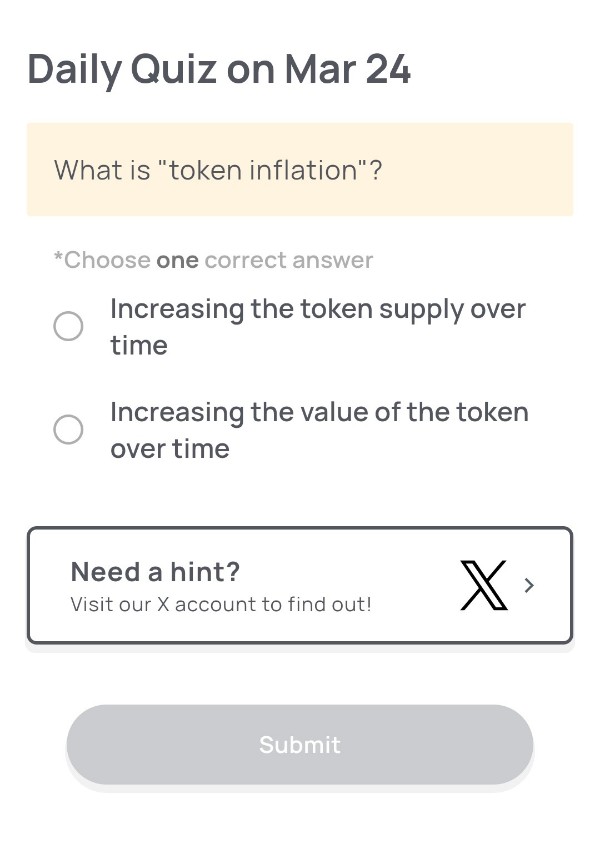
🟢Quiz Questions:
What is “token inflation”?
🟢Choose one correct answer:
・Increasing the token supply over time
・Increasing the value of the token over time
🟢Answer:
Increasing the token supply over time
🟢Reason for choosing this answer:
“Token inflation” refers to the increase in the total supply of a cryptocurrency token over time. This is similar to how inflation in traditional economics refers to the increase in the money supply, which can lead to a decrease in purchasing power. Token inflation often occurs as part of a project’s reward or mining mechanism, where new tokens are continuously issued to incentivize participation or secure the network.
🟢Trivia:
Xenea controls token inflation through a mechanism called halving, where mining rewards (in XENE) are reduced by 50% every two years. This method slows the increase in token supply, helping maintain scarcity and long-term value. For example, in the first year after mainnet launch, 300 XENE are issued per minute, but this drops to 150 XENE in the third year.
Daily Quiz on Mar 23
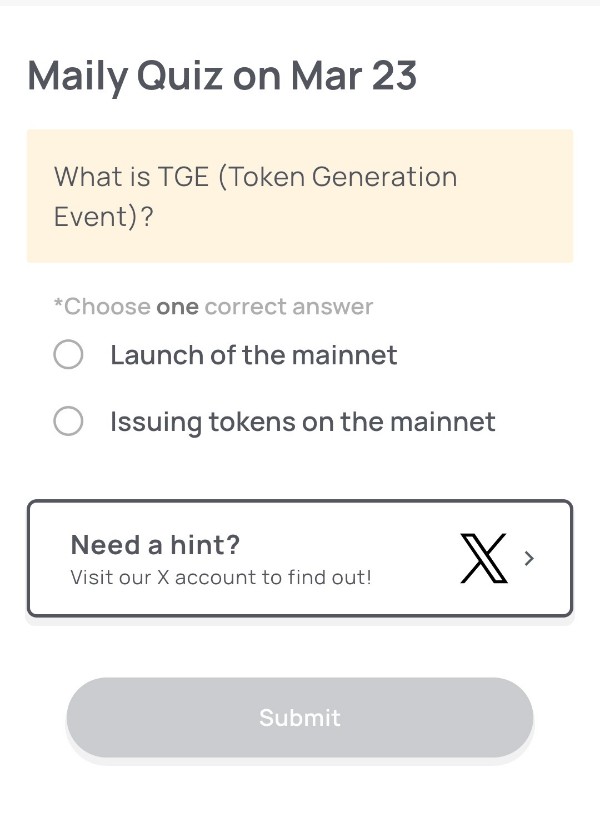
🟢Quiz Questions:
What is TGE (Token Generation Event)?
🟢Choose one correct answer:
・Launch of the mainnet
・Issuing tokens on the mainnet
🟢Answer:
Issuing tokens on the mainnet
🟢Reason for choosing this answer:
A Token Generation Event (TGE) specifically refers to the moment when a project issues or “generates” its native token and makes it available to users, typically on a mainnet. While the TGE may coincide with the launch of a mainnet, the term itself is focused on the creation and distribution of tokens, not the network launch itself.
🟢Trivia:
TGE (Token Generation Event) is a key milestone in blockchain projects where the official issuance of tokens occurs. These tokens can serve various purposes such as utility within a platform, governance voting, staking, or even fundraising. Unlike ICOs, which are often tied to fundraising, TGEs emphasize the technical act of minting and distributing tokens, making them foundational to token economies.
Daily Quiz on Mar 22
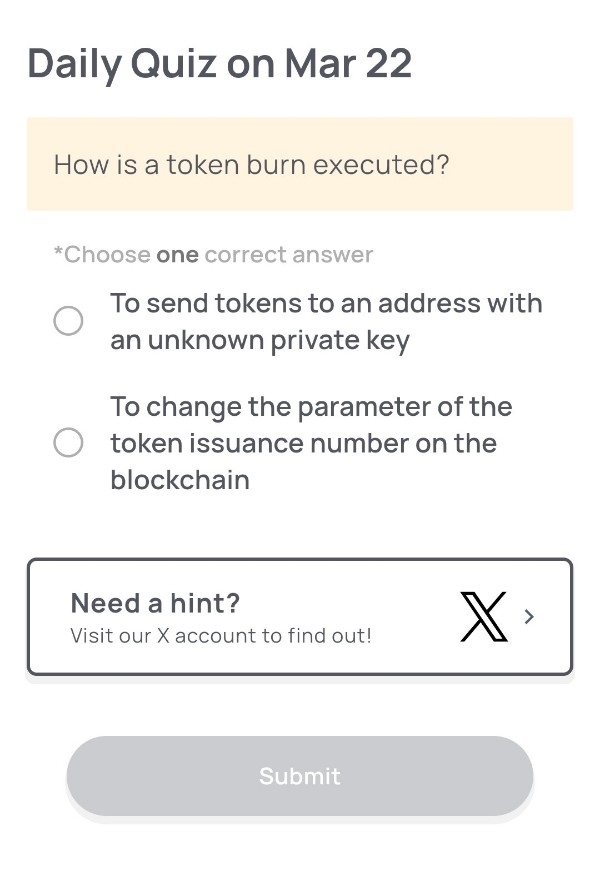
🟢Quiz Question:
How is a token burn executed?
🟢Choose one correct answer:
・To send tokens to an address with an unknown private key
・To change the parameter of the token issuance number on the blockchain
🟢Answer:
To send tokens to an address with an unknown private key
🟢Reason for choosing this answer:
Token burning is the process of permanently removing tokens from circulation. This is typically achieved by sending the tokens to a “burn address” or an address with an unknown private key, making them irretrievable. This method is commonly used to reduce token supply and create scarcity, which may positively impact the value of the remaining tokens.
🟢Trivia:
Some blockchain networks, like Ethereum, have built-in token burn mechanisms. Ethereum’s EIP-1559 introduced a system where a portion of transaction fees (gas fees) is burned, reducing the overall supply of ETH over time. This process helps counter inflation and provides long-term value to holders.
Daily Quiz on Mar 21

🟢Quiz Question:
What can be expected from a token burn?
🟢Choose one correct answer:
・Token price will rise
・Token price will stabilize
・Token price will fall
🟢Answer:
Token price will rise
🟢Reason for choosing this answer:
Token burns reduce the total circulating supply of a cryptocurrency, making the remaining tokens scarcer. According to the basic principles of supply and demand, when supply decreases while demand remains the same or increases, the price of the asset is likely to rise. This mechanism is often used to create deflationary pressure and increase the value of a token over time.
🟢Trivia:
Some of the most well-known cryptocurrencies, such as Binance Coin (BNB) and Ethereum (ETH), implement token burn mechanisms. BNB uses a quarterly auto-burn system, while Ethereum introduced the EIP-1559 upgrade, which burns a portion of transaction fees to regulate supply dynamics and improve network economics.
Daily Quiz on Mar 20
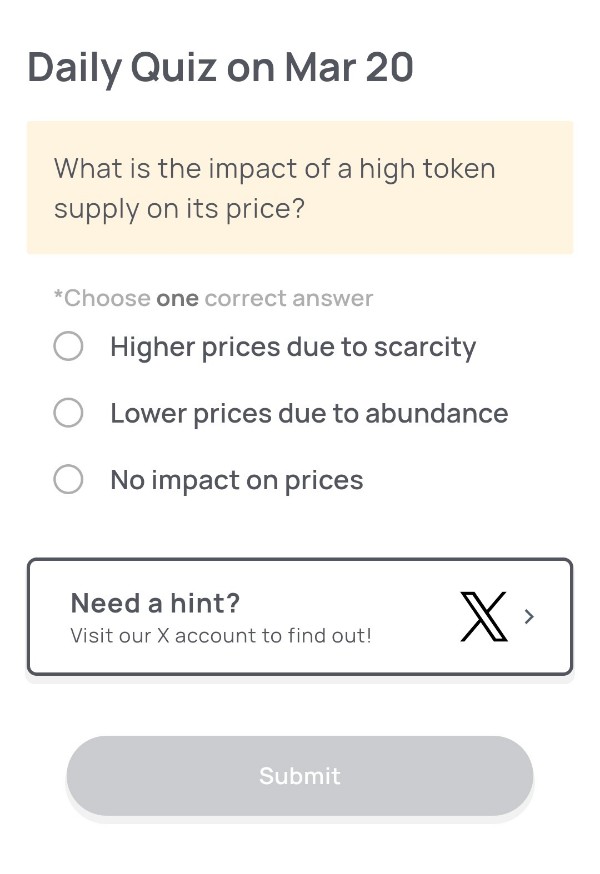
🟢Quiz Question:
What is the impact of a high token supply on its price?
🟢Choose one correct answer:
・Higher prices due to scarcity
・Lower prices due to abundance
・No impact on prices
🟢Answer:
Lower prices due to abundance
🟢Reason for choosing this answer:
When a token has a high supply, it often leads to lower prices due to the basic economic principle of supply and demand. If the supply of a token increases without a proportional rise in demand, the price tends to decrease because there are more tokens available in circulation, making them less scarce and thus less valuable.
🟢Trivia:
Some blockchain projects implement token burning to counteract inflation and maintain scarcity. For example, Ethereum’s EIP-1559 mechanism burns a portion of transaction fees, effectively reducing the total supply over time. Similarly, Binance regularly burns BNB tokens to help stabilize and potentially increase their value.
Daily Quiz on Mar 19

🟢Quiz Question:
What is token burn?
🟢Choose one correct answer:
・To increase the supply of tokens
・To reduce the supply of tokens
🟢Answer:
To reduce the supply of tokens
🟢Reason for choosing this answer:
Token burn is a mechanism used in blockchain and cryptocurrency projects to permanently remove a certain number of tokens from circulation. This is done to decrease the total supply, potentially increasing scarcity and boosting the value of the remaining tokens. The burning process is often achieved by sending tokens to an unrecoverable address, known as a “burn address,” ensuring they can never be used again.
🟢Trivia:
・Some well-known cryptocurrencies, such as Binance Coin (BNB) and Ethereum (ETH), use token burn mechanisms to control supply.
・Ethereum introduced EIP-1559 in 2021, which burns a portion of transaction fees, making ETH a deflationary asset over time.
・Token burns can help stabilize or increase a token’s price by reducing supply, similar to stock buyback programs in traditional finance.
Daily Quiz on Mar 18

🟢Quiz Question:
Which of the following factors is NOT typically part of tokenomics?
🟢Choose one correct answer:
・Token supply
・Governance model
・Token distribution
・Blockchain consensus mechanism
🟢Answer:
Blockchain consensus mechanism
🟢Reason for choosing this answer:
Tokenomics refers to the economic structure and design of a token within a blockchain ecosystem. It typically includes elements such as token supply, distribution, utility, and incentives to ensure the sustainable growth of the network.
While governance models may influence tokenomics (e.g., staking or voting rights), and token distribution is a fundamental aspect, the blockchain consensus mechanism (e.g., Proof of Work, Proof of Stake, Proof of Democracy) is a separate concept that relates to how transactions are validated and agreed upon, rather than the economics of the token itself.
🟢Trivia:
Tokenomics plays a crucial role in the success of a blockchain project. Deflationary mechanisms, staking rewards, and burn strategies are often used to influence a token’s long-term value. For example, Ethereum’s EIP-1559 introduced a burn mechanism that reduces ETH supply over time, making it potentially deflationary.
Daily Quiz on Mar 17
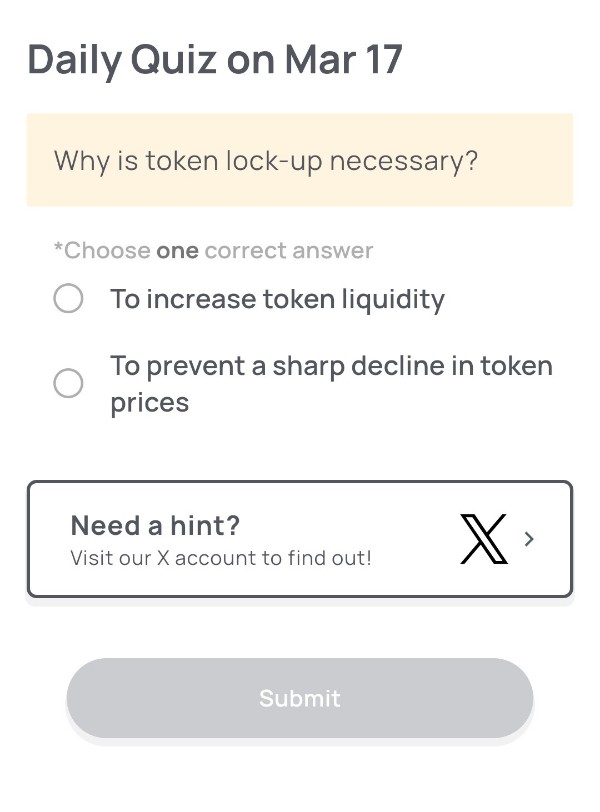
🟢Quiz Question:
Why is token lock-up necessary?
🟢Choose one correct answer:
・To increase token liquidity
・To prevent a sharp decline in token prices
🟢Answer:
To prevent a sharp decline in token prices
🟢Reason for choosing this answer:
Token lock-up is used to stabilize token prices by preventing large-scale sell-offs. When tokens are locked for a certain period, early investors and team members cannot sell their holdings immediately, reducing the risk of a sudden price drop. This helps maintain market confidence and prevents excessive volatility.
🟢Trivia:
Many blockchain projects implement vesting schedules to gradually release locked tokens over time. For example, Ethereum’s early investors had lock-up periods to ensure price stability, and even major exchange tokens like Binance’s BNB have token burn and lock-up mechanisms to support long-term value growth.
Daily Quiz on Mar 16

🟢Quiz Question:
What does “cliff” mean in tokenomics?
🟢Choose one correct answer:
・The period during which investors do not receive tokens
・The total period required for token distribution to investors
🟢Answer:
The period during which investors do not receive tokens
🟢Reason for choosing this answer:
In tokenomics, a “cliff” refers to an initial period during which investors, team members, or other stakeholders do not receive any tokens. This is commonly used in vesting schedules to ensure long-term commitment and prevent early dumping of tokens. After the cliff period ends, tokens start getting released gradually according to a vesting schedule.
🟢Trivia:
Cliff periods are typically seen in startup equity compensation and crypto vesting schedules. For example, a common vesting schedule might include a 1-year cliff, meaning an investor or employee gets zero tokens for the first year, followed by monthly or quarterly distributions over the remaining vesting period. This mechanism helps align incentives between project teams and long-term investors.
Daily Quiz on Mar 15
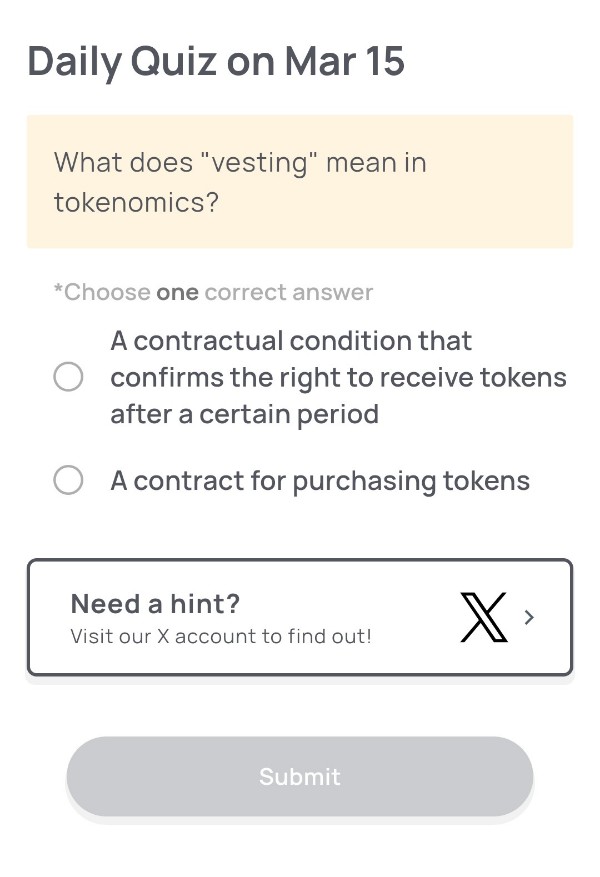
🟢Quiz Question:
What does “vesting” mean in tokenomics?
🟢 Choose one correct answer:
・A contractual condition that confirms the right to receive tokens after a certain period
・A contract for purchasing tokens
🟢Answer:
A contractual condition that confirms the right to receive tokens after a certain period
🟢Reason for choosing this answer:
In tokenomics, “vesting” refers to a predefined schedule that dictates when an individual or entity gains full ownership of allocated tokens. This mechanism is commonly used for team members, advisors, and investors in blockchain projects to prevent immediate sell-offs, ensuring long-term commitment and stability within the ecosystem.
🟢Trivia:
・Vesting schedules often include a “cliff period,” during which no tokens are distributed, followed by gradual token releases.
・Many crypto projects implement vesting to align incentives among founders, developers, and early investors, reducing the risk of market manipulation or price dumping.
・Ethereum’s Ethereum Foundation and other major projects have employed vesting structures to ensure sustained growth and development.
Daily Quiz on Mar 14
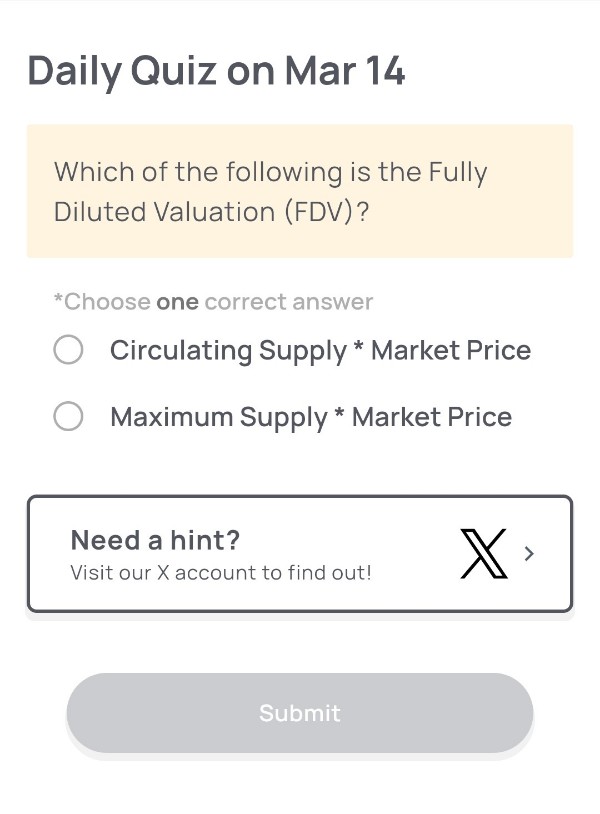
🟢Quiz Questions:
Which of the following is the Fully Diluted Valuation (FDV)?
🟢Choose one correct answer:
・Circulating Supply * Market Price
・Maximum Supply * Market Price
🟢Answer:
Maximum Supply * Market Price
🟢Reason for choosing this answer:
Fully Diluted Valuation (FDV) is a metric used to estimate the total value of a cryptocurrency if all possible tokens were in circulation. It is calculated by multiplying the maximum supply of the token by its current market price. This helps investors understand the potential market capitalization assuming full dilution.
🟢Trivia:
FDV is often compared to market capitalization, which only considers the circulating supply. A large difference between FDV and market cap can indicate potential inflation risks or a significant number of locked or vesting tokens that may enter circulation in the future.
Daily Quiz on Mar 13
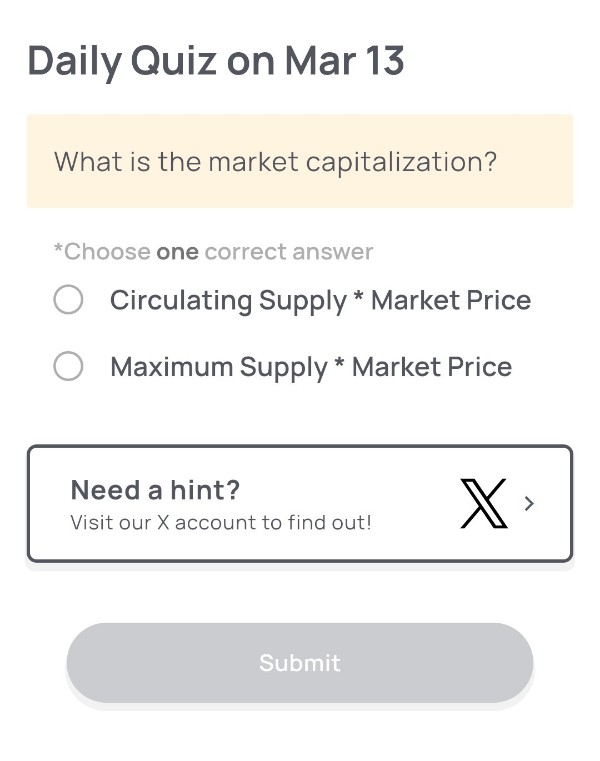
🟢Quiz Question:
What is the market capitalization?
🟢Choose one correct answer:
・Circulating Supply * Market Price
・Maximum Supply * Market Price
🟢Answer:
Circulating Supply * Market Price
🟢Reason for choosing this answer:
Market capitalization (or market cap) is a measure of the total value of a cryptocurrency. It is calculated using the formula:
Market Cap = Circulating Supply × Market Price
Circulating supply refers to the number of coins or tokens that are currently available and actively trading in the market. This is different from the maximum supply, which includes all potential future tokens that might not yet be in circulation.
🟢Trivia:
・Bitcoin’s market cap is often used as a benchmark for the overall crypto market.
・The fully diluted market cap is calculated using maximum supply, but it is not the standard method for determining a cryptocurrency’s market value.
・A higher market cap generally indicates a more established and widely adopted cryptocurrency, but it doesn’t necessarily mean a better investment.
Daily Quiz on Mar 12
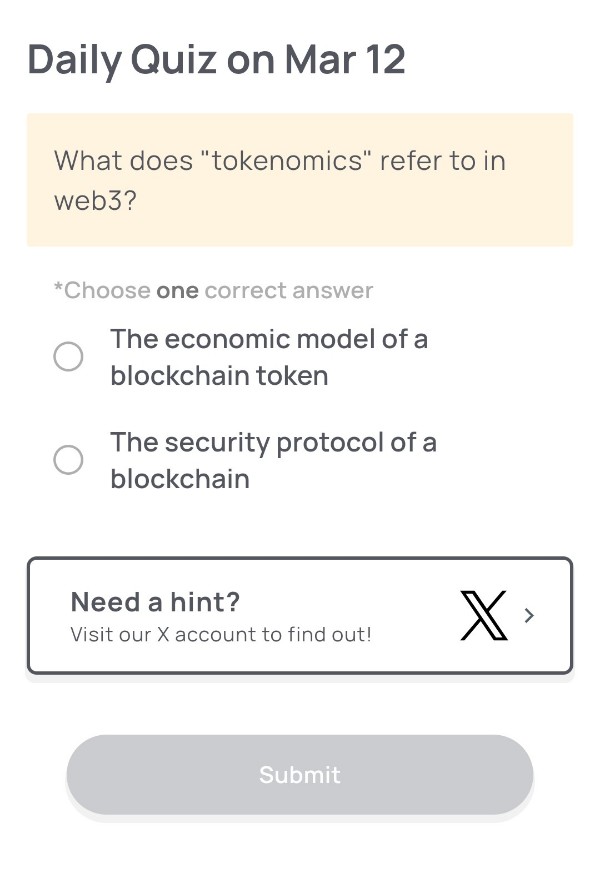
🟢Quiz Question:
What does “tokenomics” refer to in web3?
🟢Choose one correct answer:
・The economic model of a blockchain token
・The security protocol of a blockchain
🟢Answer:
The economic model of a blockchain token
🟢Reason for choosing this answer:
“Tokenomics” is a combination of “token” and “economics,” referring to the economic principles governing a blockchain token. This includes aspects such as supply, distribution, incentives, inflation mechanisms, and utility within the ecosystem. Tokenomics is crucial for determining a token’s value, scarcity, and long-term sustainability in a blockchain network.
🟢Trivia:
Many blockchain projects use a combination of token burning (reducing supply) and staking (locking tokens for rewards) to create a sustainable economy. For example, Bitcoin’s tokenomics include a hard cap of 21 million BTC, while Ethereum transitioned from Proof of Work to Proof of Stake to optimize its tokenomics model.
Daily Quiz on Mar 11
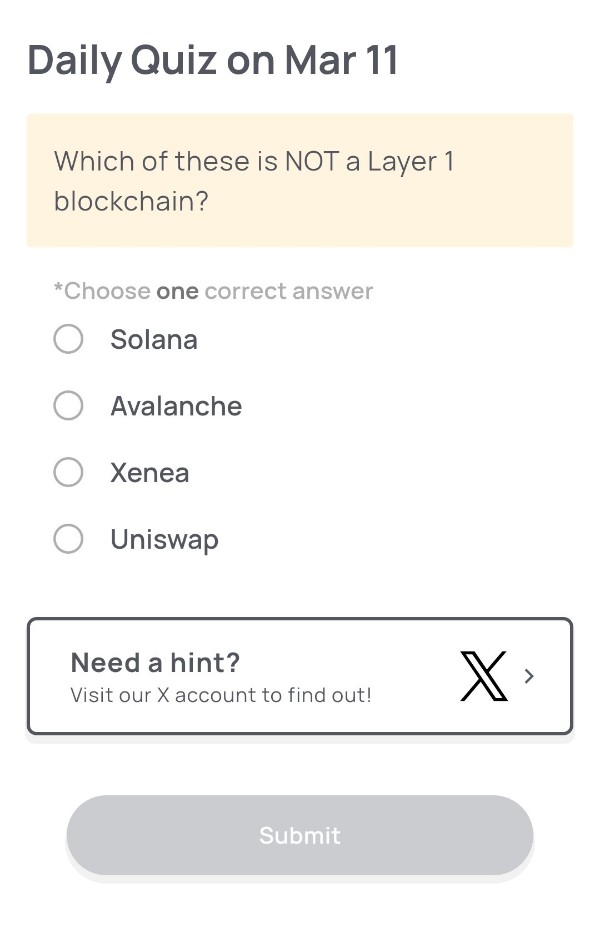
🟢Quiz Question:
Which of these is NOT a Layer 1 blockchain?
🟢Choose one correct answer:
・Solana
・Avalanche
・Xenea
・Uniswap
🟢Answer:
Uniswap
🟢Reason for choosing this answer:
・Uniswap is not a Layer 1 blockchain but rather a decentralized exchange (DEX) built on Ethereum, which is a Layer 1 blockchain. It functions as an automated market maker (AMM) that allows users to swap cryptocurrencies directly without intermediaries.
・On the other hand, Solana, Avalanche, and Xenea are all Layer 1 blockchains that provide the foundational infrastructure for decentralized applications and smart contracts.
🟢Trivia:
Uniswap was one of the first protocols to popularize automated market-making in decentralized finance (DeFi). Its unique liquidity pool model eliminates the need for traditional order books and instead uses liquidity provided by users in smart contract-based pools. The protocol is now a major player in DeFi, with billions of dollars in total value locked (TVL).
Daily Quiz on Mar 10
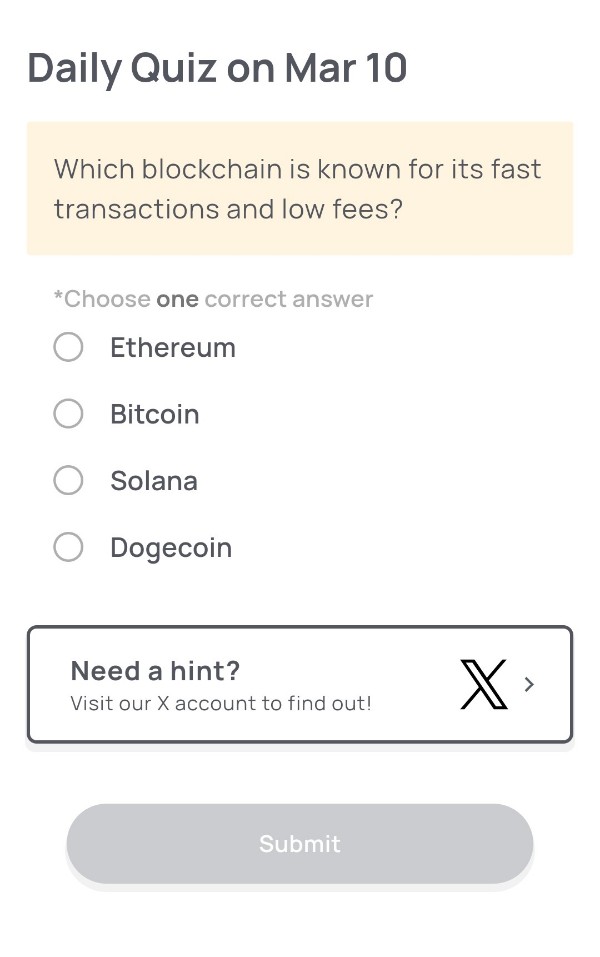
🟢Quiz Question:
Which blockchain is known for its fast transactions and low fees?
🟢Choose one correct answer:
・Ethereum
・Bitcoin
・Solana
・Dogecoin
🟢Answer:
Solana
🟢Reason for choosing this answer:
Solana is known for its high-speed transactions and low fees due to its unique Proof of History (PoH) consensus mechanism combined with Proof of Stake (PoS). This allows the blockchain to process thousands of transactions per second (TPS) at a fraction of the cost compared to Ethereum and Bitcoin.
🟢Trivia:
Solana can handle up to 65,000 TPS, making it one of the fastest blockchains in the industry. Unlike Bitcoin and Ethereum, which rely on traditional PoW and PoS mechanisms, Solana’s PoH helps maintain a chronological order of transactions, significantly improving efficiency.
Daily Quiz on Mar 9
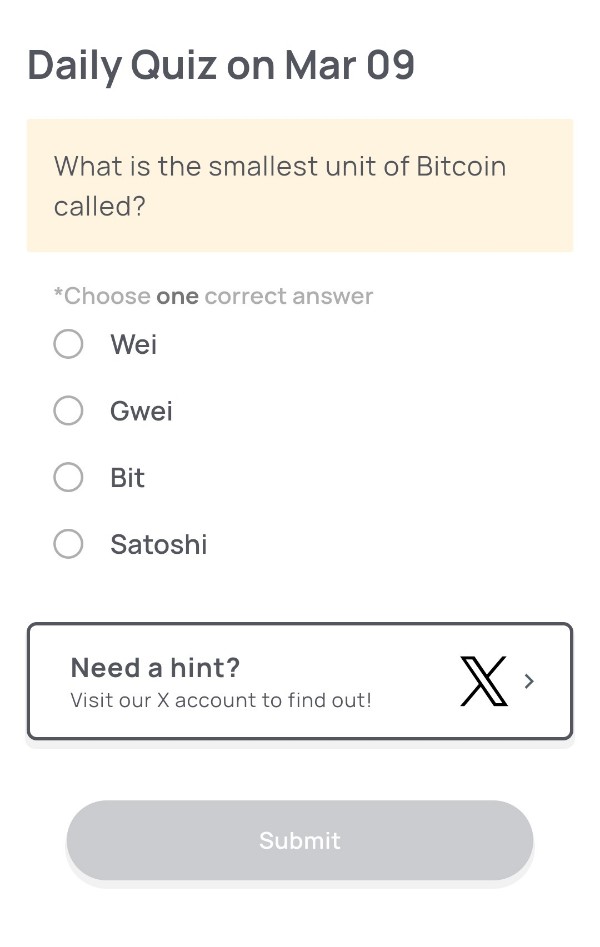
🟢Quiz Questions:
What is the smallest unit of Bitcoin called?
🟢Choose one correct answer:
・Wei
・Gwei
・Bit
・Satoshi
🟢Answer:
Satoshi
🟢Reason for choosing this answer:
The smallest unit of Bitcoin is called a “Satoshi,” named after Bitcoin’s creator, Satoshi Nakamoto. One Bitcoin (BTC) is equal to 100,000,000 Satoshis, making it the smallest indivisible unit of the cryptocurrency. This allows for microtransactions, making Bitcoin more usable for everyday transactions.
🟢Trivia:
・While “Satoshi” is the smallest unit, another commonly used fraction is the “millibit” (mBTC), which is 1/1,000th of a Bitcoin.
・Unlike Bitcoin, Ethereum uses “Wei” and “Gwei” as its smallest units. 1 Ether (ETH) is equal to 1 quintillion (1,000,000,000,000,000,000) Wei.
・Some Bitcoin enthusiasts propose using smaller denominations like mSats (millisatoshis), which would be 1/1,000th of a Satoshi, especially for the Lightning Network.
Daily Quiz on Mar 8
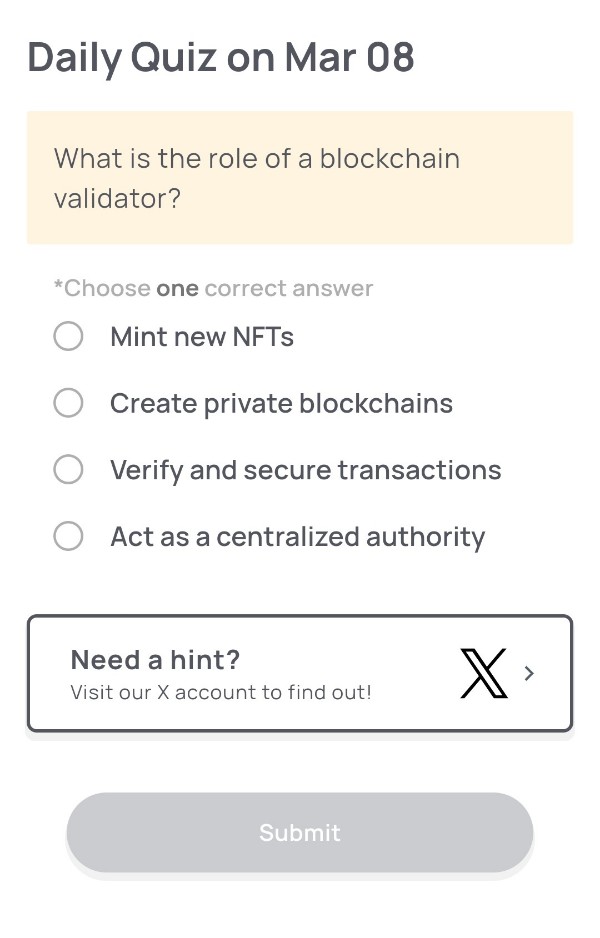
🟢Quiz Questions:
What is the role of a blockchain validator?
🟢Choose one correct answer:
・Mint new NFTs
・Create private blockchains
・Verify and secure transactions
・Act as a centralized authority
🟢Answer:
Verify and secure transactions
🟢Reason for choosing this answer:
A blockchain validator’s primary role is to verify and secure transactions. Validators ensure that all transactions added to the blockchain are legitimate and follow the consensus rules of the network. They play a crucial role in maintaining the security, integrity, and decentralization of the blockchain by preventing double-spending and validating blocks before they are added to the ledger.
🟢Trivia:
Different blockchains use different consensus mechanisms for validation. For example:
・Proof of Work (PoW): Bitcoin uses miners to validate transactions by solving complex mathematical puzzles.
・Proof of Stake (PoS): Ethereum 2.0 uses validators who stake their tokens to confirm transactions.
・Proof of Democracy (PoD): Xenea uses a unique PoD system where voting nodes participate in transaction validation, enhancing decentralization and security.
Daily Quiz on Mar 7
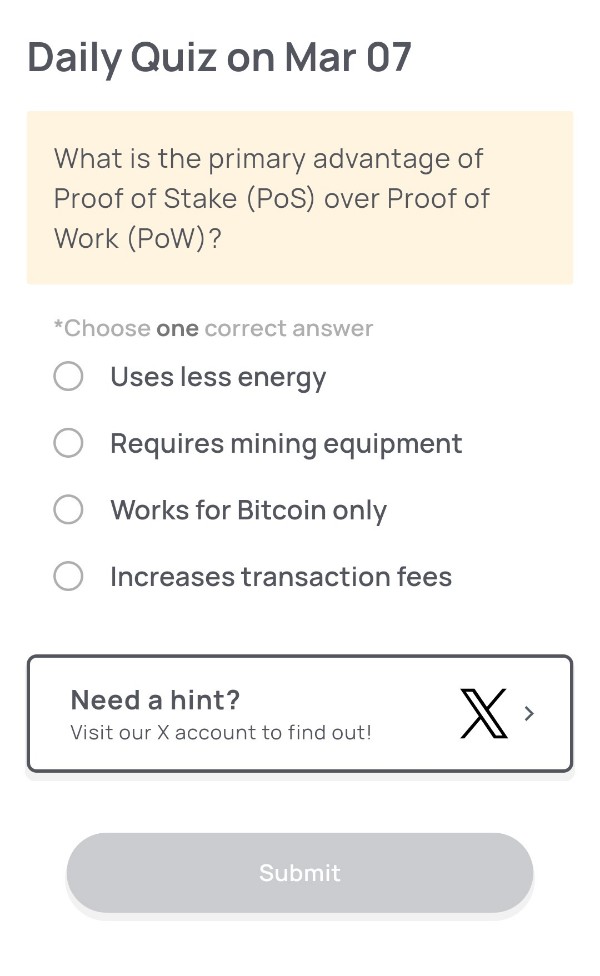
🟢Quiz Question:
What is the primary advantage of Proof of Stake (PoS) over Proof of Work (PoW)?
🟢Choose one correct answer:
・Uses less energy
・Requires mining equipment
・Works for Bitcoin only
・Increases transaction fees
🟢Answer:
Uses less energy
🟢Reason for choosing this answer:
Proof of Stake (PoS) is designed to be more energy-efficient than Proof of Work (PoW). In PoW, miners compete to solve complex mathematical puzzles, which requires high computational power and consumes large amounts of electricity. In contrast, PoS selects validators based on the number of tokens they stake, significantly reducing energy consumption.
🟢Trivia:
・Ethereum transitioned from PoW to PoS in September 2022 through “The Merge,” reducing its energy consumption by over 99%.
・Xenea uses a unique consensus algorithm called Proof of Democracy (PoD), which evolved from Voting Proof of Work (VPoW). Unlike PoW, PoD does not rely on high-energy mining but instead allows participants to validate transactions through a decentralized voting system. This mechanism enhances security while maintaining low energy consumption.
・Xenea Wallet enables users to participate in the PoD system without needing expensive mining equipment, making blockchain participation more accessible and eco-friendly.
Daily Quiz on Mar 6
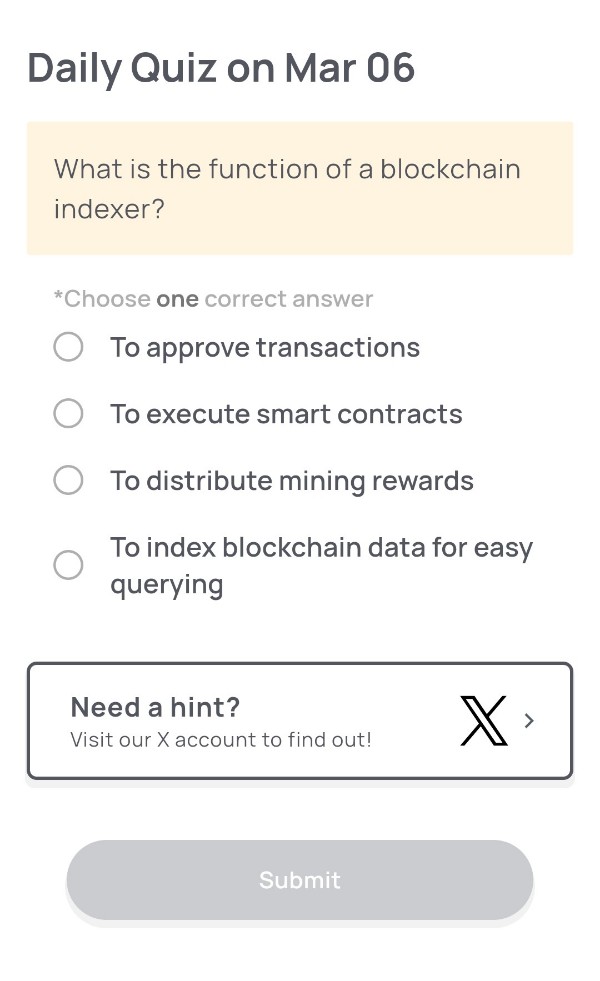
🟢Quiz Question:
What is the function of a blockchain indexer?
🟢Choose one correct answer:
・To approve transactions
・To execute smart contracts
・To distribute mining rewards
・To index blockchain data for easy querying
🟢Answer:
To index blockchain data for easy querying
🟢Reason for choosing this answer:
A blockchain indexer is a system that scans and organizes blockchain data, making it easily accessible for querying. It collects and structures data from the blockchain to enable fast and efficient searches, allowing users and applications to retrieve specific transaction histories, account balances, or smart contract interactions quickly. Without an indexer, searching for specific blockchain data would be slow and inefficient.
🟢Trivia:
Blockchain indexers play a crucial role in decentralized applications (dApps) and blockchain explorers like Etherscan or Xenea’s explorer. They improve user experience by providing real-time access to blockchain data without requiring users to run a full node. Popular indexers include The Graph (for Ethereum-based chains) and Blockchair (for multiple blockchains).
Daily Quiz on Mar 5
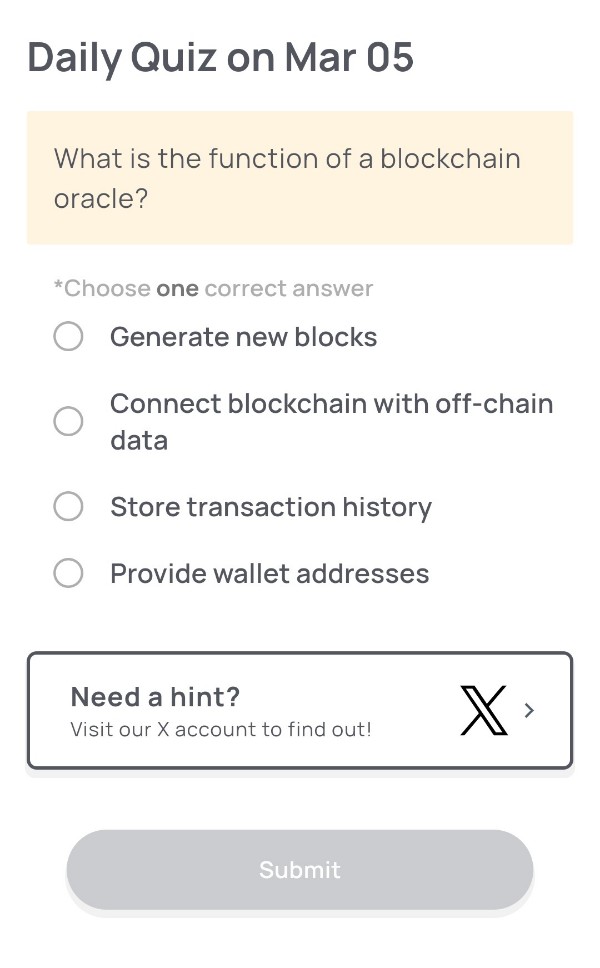
🟢Quiz Question:
What is the function of a blockchain oracle?
🟢Choose one correct answer:
・Generate new blocks
・Connect blockchain with off-chain data
・Store transaction history
・Provide wallet addresses
🟢Answer:
・Connect blockchain with off-chain data
🟢Reason for choosing this answer:
A blockchain oracle acts as a bridge between blockchains and external data sources. It enables smart contracts to interact with real-world data, such as price feeds, weather conditions, or sports results. Without oracles, blockchains would be isolated from off-chain information and unable to respond to external events.
🟢Trivia:
There are different types of blockchain oracles, including software oracles (pulling data from APIs), hardware oracles (collecting data from physical sensors), and human oracles (using trusted individuals to verify information). Chainlink is one of the most well-known blockchain oracle providers, widely used in DeFi applications.
Daily Quiz on Mar 4
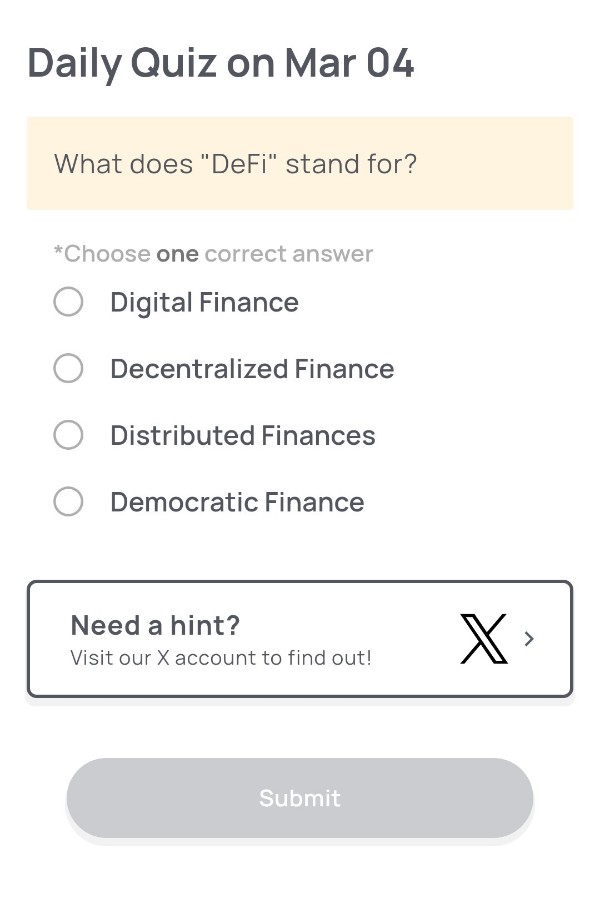
🟢Quiz Question:
What does “DeFi” stand for?
🟢Choose one correct answer:
・Digital Finance
・Decentralized Finance
・Distributed Finances
・Democratic Finance
🟢Answer:
Decentralized Finance
🟢Reason for choosing this answer:
DeFi stands for Decentralized Finance, which refers to a financial system that operates on blockchain technology without relying on traditional banks or financial institutions. DeFi uses smart contracts on blockchain networks, such as Ethereum, to provide services like lending, borrowing, trading, and earning interest without intermediaries.
🟢Trivia:
The DeFi ecosystem has grown rapidly, with billions of dollars locked in various decentralized applications (dApps). Some of the most well-known DeFi protocols include Uniswap (DEX for trading), Aave (lending/borrowing), and MakerDAO (stablecoin issuance). Unlike traditional finance, DeFi allows anyone with an internet connection to access financial services without requiring approval from a centralized authority.
Daily Quiz on Mar 3
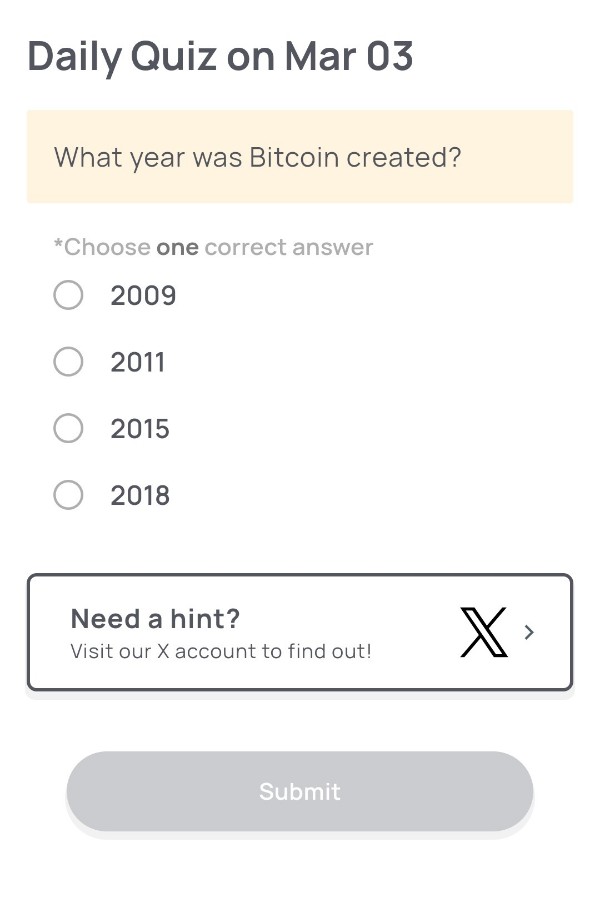
🟢Quiz Question:
What year was Bitcoin created?
🟢Choose one correct answer:
・2009
・2011
・2015
・2018
🟢Answer:
2009
🟢Reason for choosing this answer:
Bitcoin was officially launched in 2009 by an anonymous person or group known as Satoshi Nakamoto. The Bitcoin whitepaper, titled “Bitcoin: A Peer-to-Peer Electronic Cash System”, was published in October 2008, and the first block (Genesis Block) was mined on January 3, 2009.
🟢Trivia:
・The first Bitcoin transaction took place on January 12, 2009, when Satoshi Nakamoto sent 10 BTC to computer scientist Hal Finney.
・The first real-world purchase using Bitcoin happened in 2010, when a programmer named Laszlo Hanyecz bought two pizzas for 10,000 BTC, which would be worth hundreds of millions of dollars today. This day is now celebrated as Bitcoin Pizza Day (May 22).
Daily Quiz on Mar 2

🟢Quiz Questions:
What does DACS stand for in Xenea’s ecosystem?
🟢Choose one correct answer:
・Decentralized Access Control System
・Decentralized Autonomous Contents Storage
・Decentralized Adaptive Cloud Storage
・Dynamic Autonomous Computing Storage
🟢Answer:
Decentralized Autonomous Contents Storage
🟢Reason for choosing this answer:
DACS (Decentralized Autonomous Content Storage) is a core technology of Xenea, ensuring data consistency and persistence by integrating a distributed file system directly into the blockchain. This approach eliminates the risks of external storage dependency, providing secure and decentralized data storage.
🟢Trivia:
DACS includes a mechanism called Sustainable Generation Manager (SGM), which periodically replicates and migrates stored data across nodes to prevent data loss. Additionally, Fast Track Content Delivery Manager (FASTD) is incorporated to prioritize frequently accessed data for faster retrieval.
Daily Quiz on Mar 1
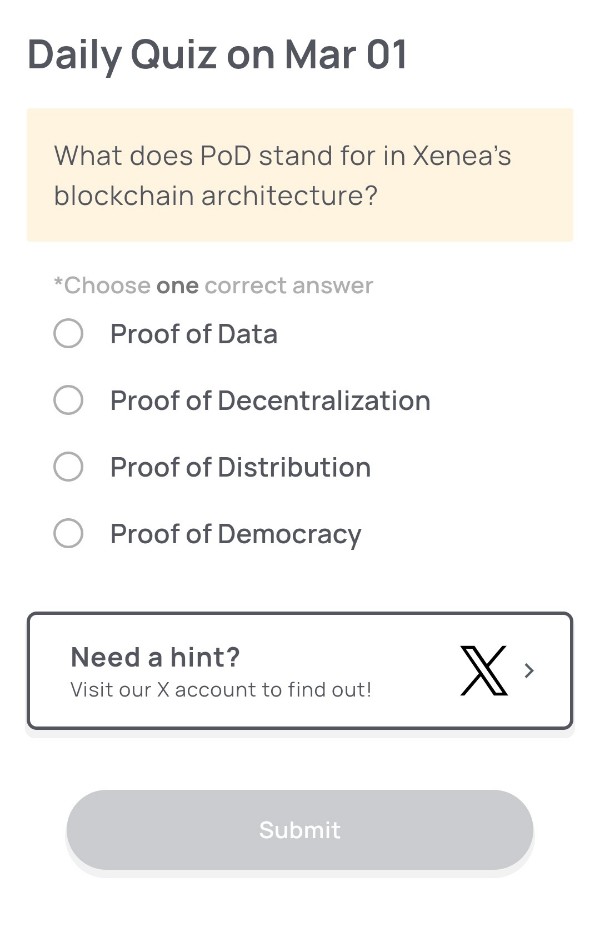
🟢Quiz Question:
What does PoD stand for in Xenea’s blockchain architecture?
🟢Choose one correct answer:
・Proof of Data
・Proof of Decentralization
・Proof of Distribution
・Proof of Democracy
🟢Answer:
Proof of Democracy
🟢Reason for choosing this answer:
Xenea’s blockchain architecture operates on the PoD (Proof of Democracy) consensus mechanism. PoD was previously known as VPoW (Voting Proof of Work) and was introduced to ensure decentralization and long-term security without relying on token price fluctuations or energy-intensive computations.
🟢Trivia:
PoD allows wallet users to participate in transaction validation by delegating their voting power to Rep Nodes. This makes it more inclusive compared to traditional consensus mechanisms like Proof of Work (PoW) and Proof of Stake (PoS). Additionally, it minimizes the risk of centralization by ensuring voting power is distributed among a broad user base.
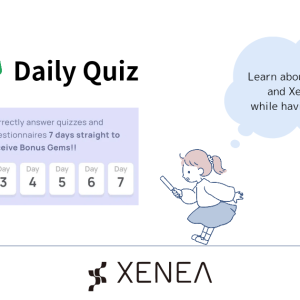
Comment